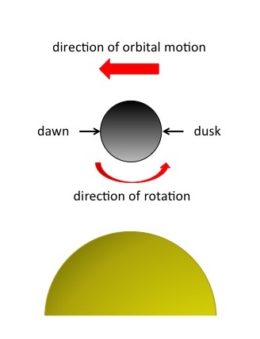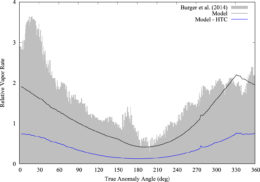If space rocks are unpleasant to encounter, space dust isn’t much better. Mercury’s cratered surface tells of billions of years of meteoroid impacts — but its thin atmosphere is what reveals its collisional history with smaller impactors. Now new research is providing a better understanding of what we’re seeing.
Micrometeoroids Ho!
The inner solar system is bombarded by micrometeoroids, tiny particles of dust (on the scale of a tenth of a millimeter) emitted by asteroids and comets as they make their closest approach to the Sun. This dust doesn’t penetrate Earth’s layers of atmosphere, but the innermost planet of our solar system, Mercury, doesn’t have this convenient cushioning.
Just as Mercury is affected by the impacts of large meteoroids, it’s also shaped by the many smaller-scale impacts it experiences. These tiny collisions are thought to vaporize atoms and molecules from the planet’s surface, which quickly dissociate. This process adds metals to Mercury’s exosphere, the planet’s extremely tenuous atmosphere.
Modeling Populations

Distribution of the directions from which meteoroids originate before impacting Mercury’s surface, as averaged over its entire orbit. Local time of 12 hr corresponds to the Sun-facing side. A significant asymmetry is seen between the dawn (6 hrs) and dusk (18 hrs) rates. [Pokorný et al. 2017]
Pokorný and collaborators argue that two meteoroid populations — Jupiter-family comets (short-period) and Halley-type comets (long-period) — contribute the dust for the majority of micrometeoroid impacts on Mercury. The authors model the dynamics and evolution of these two populations, reproducing the distribution of directions from which micrometeoroids strike Mercury during its yearly orbit.

Schematic of Mercury in its orbit around the Sun. The dawn side leads the orbital motion, while the dusk side trails it.
Geometry of an Orbit
Mercury’s orbit is unique in our solar system: it circles the Sun twice for every three rotations on its own axis — so if you were on Mercury, you’d see a single day pass over the span of two years. As with all prograde planets, the edge leading the Mercury’s orbit marks the dawn terminator, while the edge trailing the planet’s orbital motion marks the dusk terminator.
Pokorný and collaborators find a significant asymmetry in the impact vaporization that occurs on Mercury’s dawn side versus its dusk side. This is due to impact geometry (since the dusk side is shielded from impacts in the direction of motion) and seasonal variation of the dust/meteoroid environment around the planet. The authors show that the source of impact vaporization shifts toward the nightside as Mercury approaches aphelion, and toward the dayside when the planet approaches the Sun.
Importance of Long-Period Comets

Seasonal variations of the relative vaporization rate from the authors’ model (black line) compared to measurements of Mercury’s exospheric abundance of Ca. The contribution of long-period comets is shown by the blue line. [Pokorný et al. 2017]
What makes Pokorný and collaborators’ model work so well? Their inclusion of the long-period, Halley-type comets is key: the high impact velocity of the micrometeoroids produced by this family play a significant role in shaping the impact vaporization rate of Mercury’s surface.
This work successfully demonstrates that we can use measurements of Mercury’s exosphere as a unique tool to constrain the dust population in the inner solar system.
Citation
Petr Pokorný et al 2017 ApJL 842 L17. doi:10.3847/2041-8213/aa775d

4 Comments
Pingback: June 30, 2017 | Colorado Space News
Pingback: Cómo las colisiones diminutas influyen en Mercurio – Observatori Astronòmic
Pingback: Julio 2017 – Observatori Astronòmic
Pingback: Un Mercurio continuamente bombardeado « SEDA / LIADA - RedLIADA - Cursos LIADA - Cielo del Mes - Fenómenos Astronómicos - RELEA